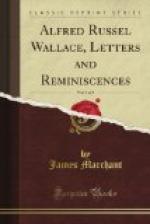The many interests of his new life, together with the use of a pocket sextant, prompted him to make various experiments for himself. The only sources from which he could obtain helpful information, however, were some cheap elementary books on mechanics and optics which he procured from the Society for the Diffusion of Useful Knowledge; these he studied and “puzzled over” for several years. “Having no friends of my own age,” he wrote, “I occupied myself with various pursuits in which I had begun to take an interest. Having learnt the use of the sextant in surveying, and my brother having a book on Nautical Astronomy, I practised a few of the simpler observations. Among these were determining the meridian by equal altitudes of the sun, and also by the pole-star at its upper or lower culmination; finding the latitude by the meridian altitude of the sun, or of some of the principal stars; and making a rude sundial by erecting a gnomon towards the pole. For these simple calculations I had Hannay and Dietrichsen’s Almanac, a copious publication which gave all the important data in the Nautical Almanac, besides much other interesting matter useful for the astronomical amateur or the ordinary navigator. I also tried to make a telescope by purchasing a lens of about 2 ft. focus at an optician’s in Swansea, fixing it in a paper tube and using the eye-piece of a small opera-glass. With it I was able to observe the moon and Jupiter’s satellites, and some of the larger star-clusters; but, of course, very imperfectly. Yet it served to increase my interest in astronomy, and to induce me to study with some care the various methods of construction of the more important astronomical instruments; and it also led me throughout my life to be deeply interested in the grand onward march of astronomical discovery."[2]
At the same time Wallace became attracted by, and interested in, the flowers, shrubs and trees growing in that part of Bedfordshire, and he acquired some elementary knowledge of zoology. “It was,” he writes, “while living at Barton that I obtained my first information that there was such a science as geology.... My brother, like most land-surveyors, was something of a geologist, and he showed me the fossil oysters of the genus Gryphaea and the Belemnites ... and several other fossils which were abundant in the chalk and gravel around Barton.... It was here, too, that during my solitary rambles I first began to feel the influence of nature and to wish to know more of the various flowers, shrubs and trees I daily met with, but of which for the most part I did not even know the English names. At that time I hardly realised that there was such a science as systematic botany, that every flower and every meanest and most insignificant weed had been accurately described and classified, and that there was any kind of system or order in the endless variety of plants and animals which I knew existed. This wish to know the names of wild plants, to be able to speak ... about them,




